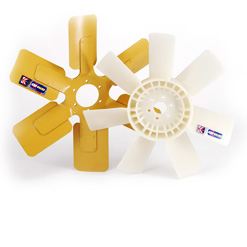KMP Replacement
engine fans
KMP ® engine fans
KMP Brand® provides an extensive selection of replacement fans blade and component parts suitable for Case IH®, Caterpillar®, Cummins®, Detroit Diesel®, Fiat®, Ford New Holland®, Iveco®, JCB®, John Deere®, Komatsu®, Massey Ferguson®, NEF®, and Perkins®. Manufactured to exceptional standards, KMP Brand® fans offer a premium alternative at a cost-effective price. Our range includes both suction and throw type, manufactured in steel, aluminium and plastic, as per the requirement of engine application and OEM specification.



How do I know if my fan is throw or suction (push or pull)?
- Front-Facing Fan (Push): If the fan is mounted on the front side of the radiator, facing the engine, it is likely a push-type fan.
In this configuration, the fan pushes air through the radiator, helping to dissipate heat. - Rear-Facing Fan (Pull): If the fan is mounted on the engine side of the radiator, facing away from the engine, it is likely a pull-type fan.
In this configuration, the fan pulls air through the radiator from the engine side, aiding in cooling. - Check for Airflow Direction: Run the engine until it reaches normal operating temperature.
Observe the direction of airflow while the fan is operating. You can do this by feeling the airflow with your hand or using a piece of paper placed near the radiator. If the air is blowing towards the engine, it’s a push-type fan. If the air is being drawn away from the engine, it’s a pull-type fan. - Inspect the Fan Blades: Examine the shape and design of the fan blades. Push-type fans typically have curved blades that push air through the radiator, while pull-type fans may have straighter blades designed to pull air from the radiator.
- Consult Vehicle Documentation: Check the vehicle’s owner’s manual or technical specifications to see if it provides information about the fan type. It may specify whether the radiator fan is a push or pull configuration.
What does the fan do on an engine?
- Heat Dissipation: The engine generates a significant amount of heat during combustion. If this heat is not effectively managed, it can lead to overheating, which may result in damage to engine components. The cooling fan helps dissipate this heat by directing air over the engine and the radiator.
- Radiators and Cooling System Support: In many vehicles and heavy machinery, the cooling fan is positioned near the radiator. The radiator cools the engine coolant, and the fan assists in enhancing the heat exchange process. As the fan pulls air through the radiator, it helps dissipate the heat absorbed by the coolant, promoting efficient cooling.
- Idle and Low-Speed Cooling: When a vehicle is stationary or moving at low speeds, the natural airflow through the radiator may be insufficient to cool the engine effectively. The cooling fan ensures a constant flow of air, providing additional cooling during these conditions.
- Temperature Regulation: The fan is typically controlled by a thermostat or a temperature sensor. When the engine temperature rises above a certain threshold, the fan is activated to increase airflow and cool the engine. Once the temperature drops to a safe level, the fan may turn off.
Why Choose KMP Engine Fans?
Quality Assured: Our quality assurance processes, ensure that every KMP Brand product meets exceptional quality standards.
Consistent Reliability: Known for dependable performance, KMP parts deliver consistent reliability, reducing downtime and enhancing overall engine operation.
Durability: Engineered to high standards, KMP parts are built for durability, with robust materials and precision manufacturing to withstand demanding conditions.
Cost-Effective: KMP provides a premium alternative at a cost-effective price, allowing customers to benefit from top-quality components without compromising their budget.
Comprehensive Range: KMP Products offers a comprehensive selection of fans for Case IH®, Caterpillar®, Cummins®, Detroit Diesel®, Fiat®, Ford New Holland®, Iveco®, JCB®, John Deere®, Komatsu®, Massey Ferguson®, NEF®, and Perkins® engines.
